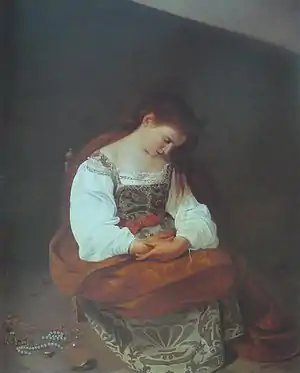Reuige Magdalena (Caravaggio)
Die Reuige Magdalena (Originaltitel Maddalena penitente) ist ein gemaltes Portraitbildnis von Caravaggio, das die reuige Maria Magdalena (Maria aus Magdala) abbildet. Es entstand um 1597 (andere Quellen geben 1594–1595 an) und wurde mit Ölfarben auf Leinwand gemalt.
 |
| Maddalena penitente − Reuige Magdalena − |
|---|
| Michelangelo Merisi da Caravaggio, ca. 1597 |
| Öl auf Leinwand |
| 122,5 × 98,5 cm |
| Galleria Doria Pamphilj, Rom |
Das Gemälde befindet sich heute im Palazzo Pamphilj in Rom (Galleria Doria Pamphilj).
Szene/Motiv
Die hl. Maria Magdalena Büßerin befindet sich in ihrem Versteck und sitzt zusammengesackt mit verschränkten Armen auf einem Stuhl. Sie wird am Tiefpunkt ihres Lasterlebens dargestellt, das ihr hier bewusst wird. Daneben liegen ihre Habseligkeiten auf dem Boden.[1]
Die Frau, die für Caravaggio hier Modell stand, ist dieselbe wie auf seinem Gemälde Ruhe auf der Flucht nach Ägypten (um 1597).
Maria Magdalena wurde von Caravaggio nochmals in einem späteren Gemälde in Ekstase dargestellt.
Weblinks
- Stephen Moss: M by Peter Robb. In: The Guardian. 9. Februar 2000, abgerufen am 14. Dezember 2014.
Literatur
- Mary D. Garrard: Artemisia Gentileschi around 1622: the shaping and reshaping of an artistic identity. University of California Press, 2001, ISBN 978-0-520-22841-2.
- Giulio Mancini (ca. 1617–1621) Considerazioni sulla pittura. Zitiert in Howard Hibbard: Caravaggio. Westview Press, 1985, ISBN 978-0-06-430128-2, S. 346 et seq.
- Kimberley Christine Patton, John Stratton Hawley: Holy tears: weeping in the religious imagination. Princeton University Press, 2005, ISBN 978-0-691-11444-6 (Google Books [abgerufen am 24. Dezember 2014]).
- Peter Robb: M: The Man Who Became Caravaggio. Macmillan, 2001, ISBN 978-0-312-27474-0.
- Ingrid Drake Rowland: From heaven to Arcadia: the sacred and the profane in the Renaissance. New York Review of Books, 2005, ISBN 978-1-59017-123-3.
- Hilary Spurling: The New York Times Book Reviews 2000. Taylor & Francis, 2001, ISBN 978-1-57958-058-2, The Other Michelangelo, S. 396 et seq (Google Books [abgerufen am 14. Dezember 2014]).
- Carol Strickland, John Boswell: The annotated Mona Lisa: a crash course in art history from prehistoric to post-modern. Andrews McMeel Publishing, 1992, ISBN 978-0-8362-8005-0 (Google Books [abgerufen am 14. Dezember 2014]).
- John L. Varriano: Caravaggio: the Art of Realism. Penn State Press, 2006, ISBN 978-0-271-02717-3 (Google Books [abgerufen am 14. Dezember 2014]).
- Genevieve Warwick: Caravaggio: Realism, Rebellion, Reception. University of Delaware Press, 2006, ISBN 978-0-87413-936-5 (Google Books [abgerufen am 14. Dezember 2014]).
Einzelnachweise
- Patton and Hawley (2005), p. 219.